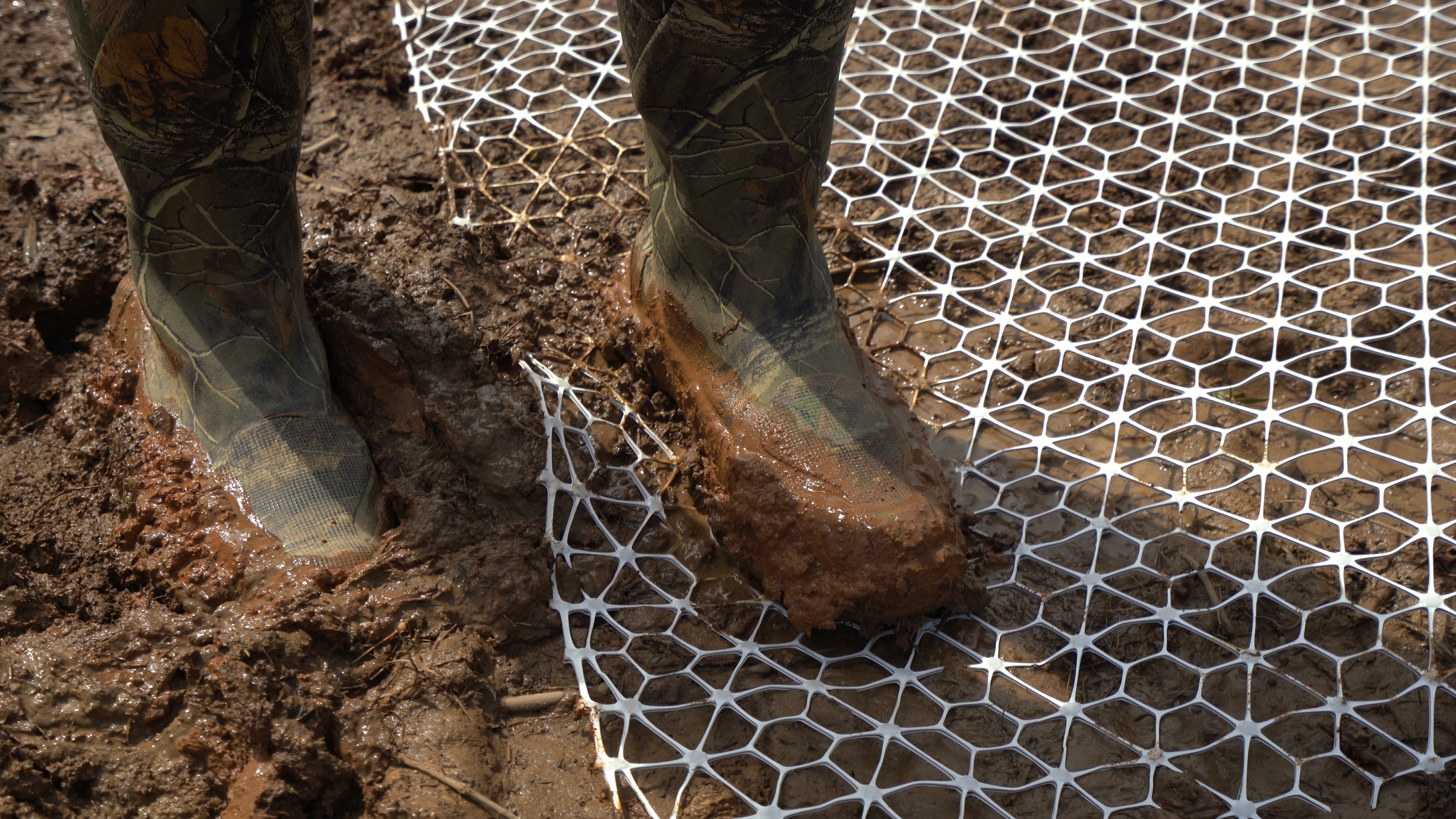Soil Permeability: Definition, Tests, and Formulae
by Kasia Zamara, on August 29, 2024
Soil permeability is a measure of how quickly water passes through a soil. This is important information for any engineering structure located on, in, or under the soil. The presence of water affects soil properties. Water passing into or through a soil will impact upon the soil strength and stresses. Leakage rates through earth dams or storage ponds clearly relate to the soil permeability, but the geotechnical settlement and stability of earth embankments are also highly dependent upon foundation soil permeability. The effectiveness and importance of drainage along a haul road will also depend upon the permeability of the subgrade soil. Soil permeability is therefore important.
Over the course of this post, we'll look at:
- What is the permeability of soil?
- What affects the permeability of soil?
- Why is soil permeability important?
- Soil permeability tests
- Permeability of soil formula
- Permeability values for different soil types
- Integrating soil permeability into construction planning
If you're particularly interested in one section, use the links above to navigate to it.
Need design support for a project with complex soil permeability considerations? Speak to our team for a free consultation.
What is the permeability of soil?
The permeability of a soil is the capacity of the soil to allow water to pass through it. It is typically quantified by the coefficient of permeability (k) and is calculated by the volume of water (m³) that can flow through a unit area of soil (m²) per second (m/s) under a hydraulic gradient.
Permeability, or hydraulic conductivity, refers to the rate at which a fluid flows through a porous medium. According to Darcy’s Law, the flow rate of water through soil depends on the hydraulic gradient, which is the difference in pressure between two points. This rate is influenced by fluid viscosity, temperature, particle size, void content, and the soil’s composition.
.png)
Low soil permeability can lead to water ponding and weakening of the subgrade during construction.
What affects the permeability of soil?
Soil permeability is influenced by several key factors, primarily the structure and composition of the soil. Soils consist of particles with interconnected voids, which can be filled with air or water. If all voids are filled with water, the soil is said to be saturated. If only a proportion of the voids are water-filled, the soil is partially saturated. Water moves through these voids, not the soil particles themselves, and its flow is driven by pressure differences (hydraulic head) or suction from plant roots due to transpiration.
Several factors affect soil permeability:
- Particle Size: The physical characteristics of soil particles, including their size, shape and texture, impact how easily water flows through the soil.
- Void Ratio: The volume of voids in the soil, or void ratio, determines how much space is available for water movement. A higher void ratio generally means higher permeability.
- Degree of Saturation: The amount of water filling the voids affects how readily additional water can pass through.
- Compaction: As soil is compacted, the void ratio decreases, reducing permeability.
Stratification of the soil also influences permeability. Where soils are built up in layers, during construction or by deposition, it is likely that permeability will be greater horizontally than vertically across the layer boundaries. This effect can be particularly pronounced in lateritic soil, where dense layering can further reduce vertical permeability.
.png)
Saturated low permeability soils present problems for road – use of a stabilisation geogrid such as Tensar InterAx, protects the weak subgrade and enables placement and compaction of the subbase above.
Why is soil permeability important?
Soil permeability is essential for various geotechnical engineering applications, particularly in the design and stability of earth structures, such as embankments. As soils are loaded, water within the soil increases pressure, known as pore pressure. Increased pore pressure reduces particle-to-particle contact and reduces soil strength. The excess pore pressure slowly dissipates as water flows out of the soil and the soil consolidates.
The rate of pore pressure dissipation will be influenced by the permeability of the soil. Low permeable soil will take longer to consolidate. This has an impact on the rate of strength gain and also the rate of settlement, both of which are important for all earth structures. For roadways and traffic areas, the permeability of the subgrade soil will have a marked effect on the subgrade strength during and after construction. A saturated soil strength may therefore be more appropriate for road design, particularly during the construction phase.
Soil permeability tests
Soil permeability is typically obtained from samples taken to the laboratory. There are two types of laboratory test: the Falling Head Test and the Constant Head Test. Standard test protocols are available, such as ISO. 17892-11:2019.
Falling Head Test
In this form of test, the differential pressure (the head) through the sample is allowed to decrease as water infiltrates the sample. Thus there is diminishing pressure over the course of the test. This type of test is generally limited to fine-grained soils.
Constant Head Test
In this test, the differential pressure (the head) across the sample remains constant throughout the test. This test is equally valid for gravel, sand and clay soils.
Field Testing
Field testing for soil permeability can involve simple percolation tests, where a hole is filled with water and the time it takes for the water level to drop indicates permeability. More reliable field test methods, like pump tests, measure water flow and pressure from boreholes to calculate permeability.

Simple Field Percolation Test – measuring the rate of drop in water level in an accurately sized hole enables calculation of saturated soil conductivity, an indicator of soil permeability.
Field tests often provide more accurate results than laboratory tests because they account for larger samples and natural variations in soil, such as fissures and cracks, that lab tests might miss. Laboratory-size samples will not be large enough to become a representative of the actual layer variability. If soil permeability is critical to your project, it is advisable to run sensitivity checks to verify how changes in soil permeability could impact your design.
Permeability of soil formula
The basic formula for soil permeability, also derived from Darcy’s Law, is:
q=k⋅A⋅ΔhLq = k \cdot A \cdot \frac{\Delta h}{L}q=k⋅A⋅LΔh
Where:
- q is the discharge or flow rate (volume per time, such as m³/s).
- k is the coefficient of permeability (or hydraulic conductivity), typically measured in metres per second (m/s).
- A is the cross-sectional area through which the fluid flows (m²).
- Δh\Delta hΔh is the difference in hydraulic head (the difference in water pressure levels) across the length of the sample (m).
- L is the length over which the head loss occurs (m).
This permeability of soil formula, based on Darcy’s Law, is essential in determining how easily water can flow through soil, which has critical implications for various geotechnical engineering projects.
Permeability values for different soil types
The permeability of a soil type, which determines how easily water can flow through it, can vary significantly based on factors like compaction and saturation in its natural setting. The coefficient of permeability (k) measured under standard laboratory test conditions does enable a hierarchy of soil types to be made. The table below lists soils in order of reducing permeability (k, measured in m/sec).
Integrating soil permeability into construction planning
Soil permeability will be a major consideration for the design of earth dams and embankments. It influences water flow, seepage patterns, and the equilibrium stress state of the embankment and foundations. Engineers designing embankments over weak soils will also need to consider the influence of foundation soil permeability on settlement rates, settlement profile and bearing capacity.
When constructing embankments over low permeability, low strength soils, the increased loading raises pore pressure in the foundation soil. This in turn reduces the bearing capacity of the soil and the stability of the embankment being constructed. The maximum speed of embankment construction is therefore dictated by the rate of pore pressure dissipation, which is a function of permeability.
To accelerate the construction, engineers have several options. The use of vertical wick drains reduces the drainage path and accelerates pore pressure dissipation. Alongside the wick drains, geosynthetic basal reinforcements, such as Tensar Basetex can increase embankment stability. Alternatively, a stiff foundation platform like the TensarTech Stratum system can be used to increase embankment stability and reduce differential settlement across the embankment width.
Contact Tensar for design support
Soil permeability determines the rate at which water drains from the foundation soil. This has a direct influence on the allowable rate of construction for embankments and other structures. Geosynthetic solutions such as TensarTech Stratum and Tensar Basetex can help overcome these construction constraints and accelerate the construction process. The use of Tensar InterAx geogrid supports the construction of roads and trafficked areas over weak, saturated soils. Assess your project needs and compare Tensar's geogrid solutions by using our award-winning design software, Tensar+.
For further assistance with any questions or inquiries you may have, contact us or email tensarinfo-uk@cmc.com.
If you have found this post useful, you may want to take a look at our other soil-related posts below:



.jpg?width=400&height=400&ext=.jpg)